Chandrayaan 3: Launch and Discussions
Re: Chandrayaan 3: Launch and Discussions
^^^
Luna 25 weighs 1.8 tons with scientific payload of 30 kg.
Beyond earth it was propelled by Fregat space tug which was their equivalent of CH3 propulsion module.
Luna 25 weighs 1.8 tons with scientific payload of 30 kg.
Beyond earth it was propelled by Fregat space tug which was their equivalent of CH3 propulsion module.
Re: Chandrayaan 3: Launch and Discussions
Not much is in public domain (unlike CH3) for Luna 25 -- and not an expert on rockets but ...
Fregat is not equivalent of CH3 PM..
The Soyuz-2 rocket with the Fregat upper stage is a versatile launch vehicle configuration developed by the Russian space agency, Roscosmos. It combines the Soyuz-2 rocket with the Fregat upper stage, which is an advanced and adaptable upper stage designed for precise payload deployment for higher than LEO orbits --- including geostationary transfer orbit (GTO) and beyond.
Luna -25 form sources I seem to read/recall was about 800 Kg -- (Wiki, just checked, gives 'appox 1.75 tons it's source is - some https://space.skyrocket.de/ site ).
Re: Chandrayaan 3: Launch and Discussions
NASA and DARPA have recently announced their new plan to develop a Nuclear Thermal Rocket for interplanetary travel within the solar system.vnms wrote: ↑29 Aug 2023 05:56 ISRO and other organizations must now focus on nuclear powered engines as this is the future andif we want to go beyond the moon.
Building bigger rockets simply will not do as they are way too expensive and the development time is not practical.
We need to focus on reusable launchers and nuclear power based engines.
I think ISRO has proved, beyond all doubts, it's capabilities with regards to trajectories and timing (Mangalyaan and CYx)
Their NERVA program of the 1960s had carried out research toward the development of a nuclear thermal rocket.
I think that for India to go this route could be pretty expensive. Nuclear propulsion is meant for deep space onlee. So we'd better have some serious need to use such a propulsion system, if we intend to go in for the expense of developing it.
Re: Chandrayaan 3: Launch and Discussions
Any reference on how AdityaL1 will communicate with Earth , considering that the big Noisy Sun disc is always behind the satellite?
Re: Chandrayaan 3: Launch and Discussions
AdityaL1 will be communicating on S and X bands. A couple of years ago, the 2nd of the large dish antennas in Byalalu was set up to support this mission, among others. All these dish antennas fall under ISTRAC.
https://timesofindia.indiatimes.com/ind ... 652642.cms
Re: Chandrayaan 3: Launch and Discussions
Sorry for the off-topic post.Amber G. wrote: ↑26 Aug 2023 20:57
FWIW: The reason of my learning Sanskrit well was to read Surya Siddhanta in original (English Translation - especially many British scholars do not translate the text well - misses many important points.... (I know enough sanskrit to read math texts - and also Prakrit to read lot of Jain (Brahamagupts etc) texts.. (Many in math dhaga may have noticed that point....
Amber G madam, I saw that you are interested in science and also learnt Sanskrit and Prakrit to know ancient India's contribution to science.
Can you please comment on the following topic in the relevant threads if you have time ?
Swami SriYuktesvar's book, The Holy Science quotes oriental astronomy that our Sun had a dual star, as part of the dual star rotation we are now moving towards our galactic centre called Vishnu nabhi, the four Yugas are based on this movement, we fully reached Dwapara Yuga by the year 1900 , since then the massive worldwide explosion of knowledge, reduction in colonialism, slavery etc.
Presently Science has not found a dual star for the Sun, but it has found that most stars are of dual or multi-star system.
The book, 'The Yugas' by Joseph Selbie and David S gives a thorough explanation of the above. They also mentioned that in Shatapatha Brahmana this dual star system involving our Sun and the galactic centre is mentioned.
I posted a more detailed version of the above in my post in Books Folder- 2008 onwards thread 36th page.
Re: Chandrayaan 3: Launch and Discussions
Complied all info to compare planned vs actual.
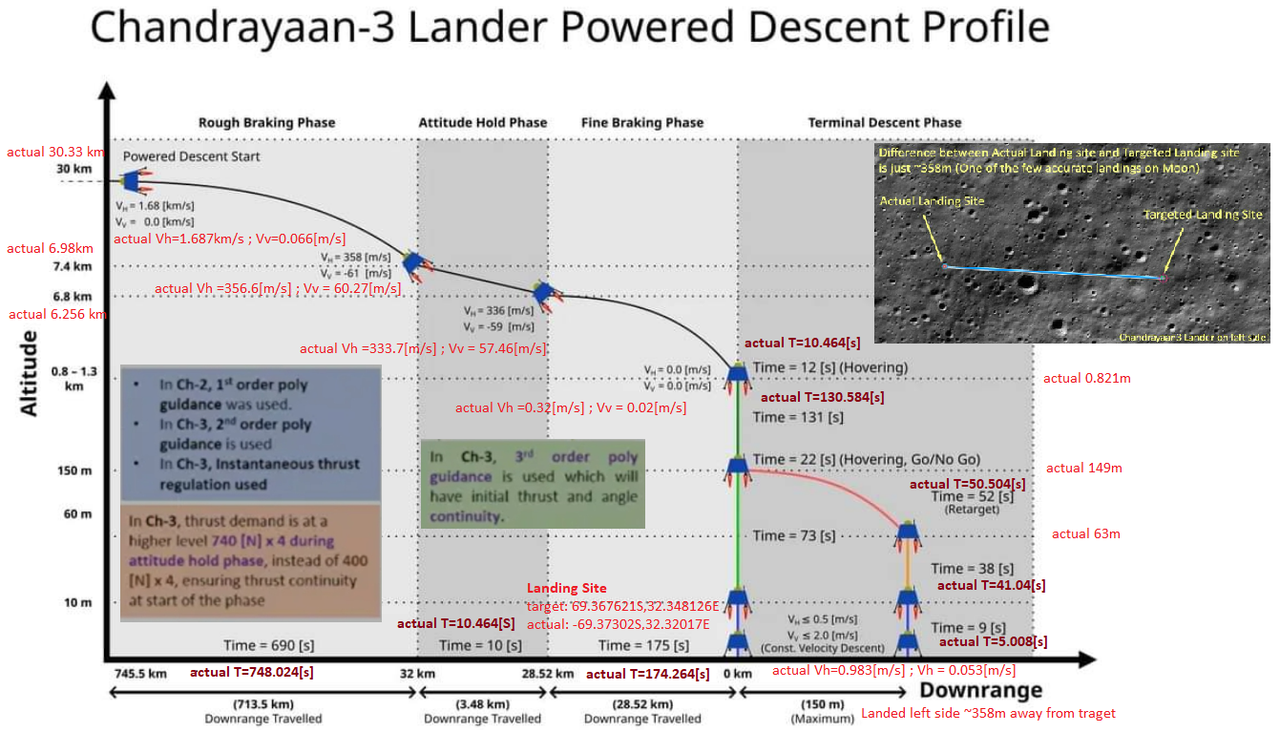

Re: Chandrayaan 3: Launch and Discussions
Meanwhile:
Recent detailed article on Lunar Rover Chang'e-4 findings - Layers Under The Surface of The Moon
Layered Structures in the Upper Several Hundred Meters of the Moon Along the Chang'E‐4 Rover's First 1,000‐m Traverse
(May require subscription)
The Chang'E-4 rover is exploring the Moon with a two-channel ground penetrating radar (GPR). The GPR sends electromagnetic pulses into the lunar interior and receives echoes from subsurface layers. They use the high-frequency channel data to detect the structure of the upper 40 m along the rover's path, primarily consisting of rock debris and soil. This analysis reveals several layers and a buried crater. The low-frequency channel has the capability to penetrate deeper into the Moon, allowing them to search for large-scale layered structures such as lava flows. Through this investigation.....multiple layers in the upper 300 m, which likely indicate a series of basalt eruptions that occurred billions of years ago. The thickness variation of these lava flows suggests a decrease in eruption scale over time. By combining data from both channels, we are able to depict the overall structure of the Moon's upper several hundred meters.
Recent detailed article on Lunar Rover Chang'e-4 findings - Layers Under The Surface of The Moon
Layered Structures in the Upper Several Hundred Meters of the Moon Along the Chang'E‐4 Rover's First 1,000‐m Traverse
(May require subscription)
(Plain Language Summary):Abstract:
We revealed the layered structure of the upper three hundred meters of the lunar surface in the South Pole-Aitken Basin by using the measurements from the Lunar Penetrating Radar (LPR) onboard the Chang'E-4 rover. The result shows that five large strata are identified by the LPR 60-MHz channel below the depth of 90 m, with thicknesses ranging from 20 m to larger than 70 m. We speculate that at least three strata are basalt flows, while the shallowest stratum is composed of multiple thin lava flows. The thickness of the strata decreases with the decreasing depth, suggesting a progressively smaller lava effusion rate over time. To evaluate the reliability of the result, a comparison was made between Chang'E-4, Chang'E-3, and ground test low-frequency data. The LPR 500-MHz channel unveiled the structure of weathered material in the top ∼40 m, revealing several layers as well as a buried paleo crater and its ejecta blanket in the regolith.
--- We examined the long-term accumulated low-frequency data of Chang'E-4 Lunar Penetrating Radar and identified several strata at depths below 90 m
---- The thickness of the strata increases with depth, implying that the lava effusion rate may have progressively decreased over time
---- The stratigraphy of the upper ∼300 m of the Moon is unveiled through the combination of low-frequency and high-frequency data
The Chang'E-4 rover is exploring the Moon with a two-channel ground penetrating radar (GPR). The GPR sends electromagnetic pulses into the lunar interior and receives echoes from subsurface layers. They use the high-frequency channel data to detect the structure of the upper 40 m along the rover's path, primarily consisting of rock debris and soil. This analysis reveals several layers and a buried crater. The low-frequency channel has the capability to penetrate deeper into the Moon, allowing them to search for large-scale layered structures such as lava flows. Through this investigation.....multiple layers in the upper 300 m, which likely indicate a series of basalt eruptions that occurred billions of years ago. The thickness variation of these lava flows suggests a decrease in eruption scale over time. By combining data from both channels, we are able to depict the overall structure of the Moon's upper several hundred meters.
Re: Chandrayaan 3: Launch and Discussions
Will be interesting to follow up on engineering details and how it turns out in practice ...
For those who are curious a few comments: From basic physics point of view: (Apart from great distance there is a constant big noisy Sun behind .)
Aditya or any spacecraft at the (L1) position face unique communication challenges due to the presence of the Sun and its associated noise, as well as the long distance from Earth. Engineers have developed techniques to ensure effective communication .. Few points;
- Antenna Design and Placement: ... specialized communication systems--- high-gain antennas -- to focus their signals toward Earth and reduce sensitivity to signals coming from other directions
Communication Frequencies: -- By using well-chosen frequencies
Deep Space Network:
(Eg NASA's Deep Space Network (DSN) These antennas are capable of receiving signals from deep space missions, including those at L1. The DSN antennas are equipped with advanced technology that enables them to filter out noise and interference, enhancing the quality of communication... similar with others.. (Also advanced signal processing..)
Space Weather Monitoring and communication scheduling:
Solar activity, such as solar flares,... Space weather monitoring is crucial to predict periods of increased solar activity and adjust communication schedules accordingly. Communication windows are carefully planned to take advantage of the spacecraft's position relative to the Sun and Earth. Engineers schedule communication sessions during times when the spacecraft is not in direct line of sight with the Sun, minimizing the effects of solar noise.
Will be exciting to see how it all turns out ..
Re: Chandrayaan 3: Launch and Discussions
Thx.
--
ISRO says Pragyan rover confirmed presence of Sulphur, detected Oxygen on moon; search for Hydrogen underway
Also ... Aluminium, Calcium, Ferrous (Iron), Chromium, Titanium, Manganese, Silicon and Oxygen as expected.
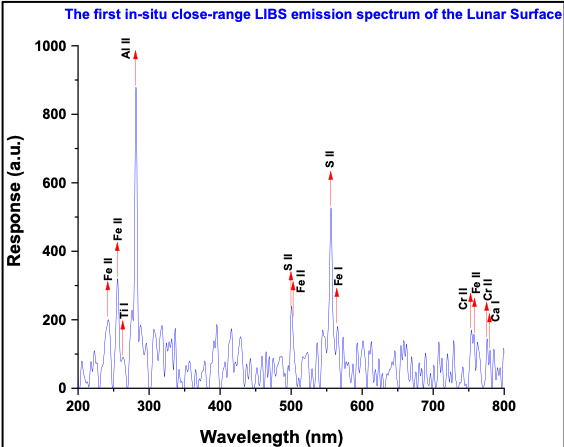
--https://www.isro.gov.in/LIBSResults.htmlIn-situ scientific experiments continue .....
Laser-Induced Breakdown Spectroscope (LIBS) instrument onboard the Rover unambiguously confirms the presence of Sulphur (S) in the lunar surface near the south pole, through first-ever in-situ measurements.
Al, Ca, Fe, Cr, Ti, Mn, Si, and O are also detected, as expected. Search for Hydrogen (H) is underway.
From Space dot com:
India to name Chandrayaan-3's moon landing site 'Shiv Shakti Point'
Re: Chandrayaan 3: Launch and Discussions
While we wait for more details, here are a few comments, why this may be a major item..
Ref: LIBS confirms the presence of Sulphur (S) on the lunar surface through unambiguous in-situ measurements
August 28, 2023
The Laser-Induced Breakdown Spectroscopy (LIBS) instrument onboard Chandrayaan-3 Rover has made the first-ever in-situ measurements on the elemental composition of the lunar surface near the south pole. These in-situ measurements confirm the presence of Sulphur (S) in the region unambiguously, something that was not feasible by the instruments onboard the orbiters.
LIBS is a scientific technique that analyzes the composition of materials by exposing them to intense laser pulses. A high-energy laser pulse is focused onto the surface of a material, such as a rock or soil. The laser pulse generates an extremely hot and localized plasma. The collected plasma light is spectrally resolved and detected by detectors such as Charge Coupled Devices. Since each element emits a characteristic set of wavelengths of light when it's in a plasma state, the elemental composition of the material is determined.
Preliminary analyses, graphically represented, have unveiled the presence of Aluminum (Al), Sulphur (S), Calcium (Ca), Iron (Fe), Chromium (Cr), and Titanium (Ti) on the lunar surface. Further measurements have revealed the presence of manganese (Mn), silicon (Si), and oxygen (O). Thorough investigation regarding the presence of Hydrogen is underway.
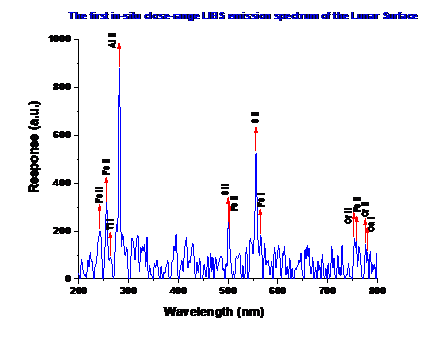 ..
..==> The LIBS technique involves analyzing materials using powerful laser pulses.
A concentrated laser pulse hits a material's surface, creating plasma. This plasma's emitted light is then captured and analyzed, with each element producing specific wavelengths in this state.
By identifying these wavelengths, the elemental makeup of the material is revealed
==> Finding deposits of sulfur near the south pole of the Moon, has interesting implications for our understanding of the Moon's past and its potential for the presence of water ice.
Few points :
-- Volcanic Activity: Sulfur is commonly associated with volcanic activity. If sulfur deposits were found, it might suggest that there were volcanic eruptions in the Moon's history that brought sulfur to the surface. This information could help us better understand the Moon's geological history and the processes that have shaped its surface over time.
-- Water Ice: The presence of sulfur might also have implications for the potential presence of water ice. The Moon's polar regions are of great interest because they are believed to have regions of permanently shadowed craters where temperatures are extremely cold. These areas could serve as "cold traps" for volatile compounds like water ice, which would be stable in these conditions. If sulfur deposits were found in close proximity to areas of potential water ice, it could provide clues about the interactions between volatile compounds and the Moon's surface.
-- Astrophysical Insights: The presence of sulfur could also provide information about the sources of material that impacted the Moon. Analyzing the composition of lunar materials can offer insights into the sources of material that have bombarded the Moon over its history, which can contribute to our understanding of the broader solar system and its formation.
-- Cutting/pasting
<click to read >
Re: Chandrayaan 3: Launch and Discussions
If they find water ice on the lunar surface, could it be highly contaminated with radioactive substances?
Re: Chandrayaan 3: Launch and Discussions
FYI - With reference to surface temperature: Frome 'Weather Channel ..
Chandrayaan-3 Lander Records 60°C Temperatures At Moon’s ‘Icy’ South Pole
Chandrayaan-3 Lander Records 60°C Temperatures At Moon’s ‘Icy’ South Pole
Re: Chandrayaan 3: Launch and Discussions
Can anyone please let me know when we launch a satellite in geostationary orbit it has to face temp ranging from -196 ºC to +128 °C, On the surface of the moon, the temp ranges from -171 ºC to +111 ºC.
If our satellites and especially this lander can survive in space for so many days, can't it survive one lunar evening?
If our satellites and especially this lander can survive in space for so many days, can't it survive one lunar evening?
Re: Chandrayaan 3: Launch and Discussions
https://en.rattibha.com/thread/1696386771410473052
As #Vikram & #Pragyan complete half their designed life, hopes of them springing back to life again after the long night that’ll follow this week, ends increase. Read more from my chat with mission ops director M Srikanth (in pic). 1/n
As #Vikram & #Pragyan complete half their designed life, hopes of them springing back to life again after the long night that’ll follow this week, ends increase. Read more from my chat with mission ops director M Srikanth (in pic). 1/n
Re: Chandrayaan 3: Launch and Discussions
thanks for sharing the chat.vijayk wrote: ↑30 Aug 2023 04:44 https://en.rattibha.com/thread/1696386771410473052
As #Vikram & #Pragyan complete half their designed life, hopes of them springing back to life again after the long night that’ll follow this week ends increase. Read more from my chat with mission ops director M Srikanth (in pic). 1/n
There was an article about Isro and Barc developing an RTG unit together for interplanetary missions. Next time onwards we may see longer duration missions like Change 4 and Opportunity.
-
sanjaykumar
- BRF Oldie
- Posts: 6118
- Joined: 16 Oct 2005 05:51
Re: Chandrayaan 3: Launch and Discussions
IR is too low energy for orbital transition and is likely solely vibrational. I can’t think of elements or compounds that have an IR emissivity when irradiated by visible light, akin to the Stokes shift. Must be examples.
Re: Chandrayaan 3: Launch and Discussions
Here we go! A picture of the lander taken by the rover -- at last!
https://twitter.com/isro/status/1696792992718442558
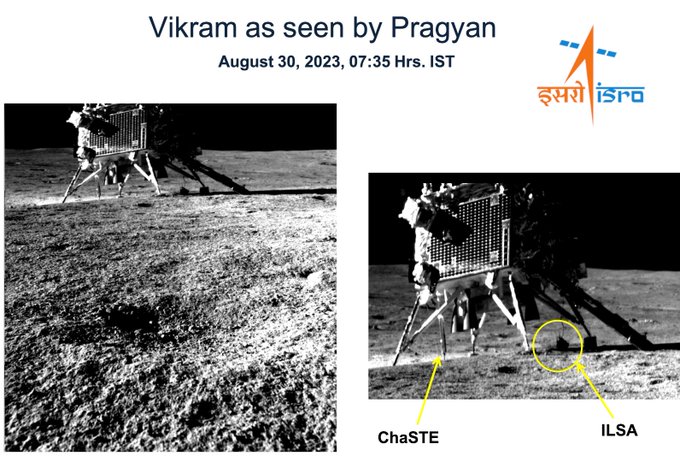
https://twitter.com/isro/status/1696792992718442558

Re: Chandrayaan 3: Launch and Discussions
1. They are unlikely to find water ice on the lunar surface
2. It's not going to be highly contaminated with radioactive substances..
https://www.science.org/content/article ... ments-show
Humans have actually been on the moon, with dosimeters. And chang'e has taken measurements, too. The moon surface is more radioactive than the earth because there is no strong magnetic field or atmosphere to stop cosmic rays and solar flares from hitting the surface. With some of them causing secondary radioactivity. But the study shows, that it may be 5-10x as much as a person in a plane receives. Legally less than nasa is permitted to expose their astronauts to. Maybe even less in shadowed places protected from.sunlight like at the poles.
Nor is there a particularly high likelihood of fissile materials like uranium etc..
https://agupubs.onlinelibrary.wiley.com ... 10GL043061
There is some uranium, thorium and samarium on the moon per above, but in ppm ...higher in magma and craters with ejectiles from magma flows
As to the chance of finding water ice on the surface... naah, super unlikely. Chandrayaan is going to places with solar incidence, so it can get solar power. The rover can't go inside deep craters because line of sight is interrupted. And quite simply, it is in the wrong place for that.
https://blog.jatan.space/p/moon-monday-issue-142
"Conditions unique to polar areas, especially when talking about the relatively large water ice deposits, such as permanently shadowed regions and adjacent maximally sunlit topographic highs are only prominent from 80° latitude onward, not around 70° where Chandrayaan 3 landed"
Jatan is accredited to scientific American, and has had news articles picked up by nature, so he's not your average blogger/media hound. He says the creators of Chandrayaan 3 tend to call it high latitude areas for sunlit areas rather than actual polar areas
In my own understanding: Water ice on surface is more likely to be found where sunlight isn't. And Chandrayaan has to go/has gone where sunlight is.
You might still find signs under the surface, but chaste goes ~ 8 cm deep and hasn't found hydrogen and is stationary, while pragyan isn't well equipped to go deep, and will travel less than 400m
Now there's potentially a lot of water on the moon, even in bulk rocks, just as there can be inside the earth's mantle. But it could also be bound up in minerals, and the Moon's crust elsewhere (eg apollo) has been described as drier than the sahara. You might still wring water by processing even there, but it might be a lot of processing. Now Chandrayaan has gone to high latitude areas so not exactly the same as apollo etc. You might still pick up on some data. But Artemis 3 and lupex are more likely to investigate the likelier areas. In some years time
Last edited by Barath on 30 Aug 2023 15:12, edited 2 times in total.
Re: Chandrayaan 3: Launch and Discussions
The next indian/joint moon mission is lupex/Chandrayaan 4 in a few years time (2026+). Too early to really say, but I think jaxa is still talking solar. But the missions are going to be longer and it is polar regions. Let's wait for updates . After all, the lander will be indian. Even radioisotope for heat and solar+batteries for power has been tried before on the moon..
https://sdgs.jaxa.jp/en/article/detail/13.html
BTW, though it is only getting limelight now, rtg development dates back to this 2021 call for eoi proposals to develop 100W rteg in 3 stages..
https://www.orfonline.org/expert-speak/ ... -in-space/
Re: Chandrayaan 3: Launch and Discussions
If this has been posted before, my apologies.
https://twitter.com/TimesAlgebraIND/sta ... 42737?s=20 ---> Chandrayaan 3 detects oxygen on moon. Hunt for hydrogen is underway. Chandrayaan 3 also confirms the presence of Sulphur in the lunar surface near the south pole. World is shocked to see MIRACLES ON MOON. Silicon, Calcium, Iron, Chromium, Titanium, Manganese and Aluminum also detected
https://twitter.com/TimesAlgebraIND/sta ... 42737?s=20 ---> Chandrayaan 3 detects oxygen on moon. Hunt for hydrogen is underway. Chandrayaan 3 also confirms the presence of Sulphur in the lunar surface near the south pole. World is shocked to see MIRACLES ON MOON. Silicon, Calcium, Iron, Chromium, Titanium, Manganese and Aluminum also detected
Re: Chandrayaan 3: Launch and Discussions
Just because we are looking forward to AdityaL1...
There are following similar sounding objects in cosmos:
ADITI
ADITISINGH
ADISESHAN
ADITYAJAIN
ADITYAMOHAN
There are following similar sounding objects in cosmos:
ADITI
ADITISINGH
ADISESHAN
ADITYAJAIN
ADITYAMOHAN
Re: Chandrayaan 3: Launch and Discussions
No, I think the method relies on generating plasma where pretty much all components are in elemental state, and then identifying electronic orbital transitions as the plasma cools back down (and electrons cascade to lower orbits). So it's not actually looking for vibe-rotational bands as in water or water vapor, but flashing the water (if any exists - probably the wrong technical term here) to elemental hydrogen and oxygen and then looking for transitions in these elemental states. The oxygen probably came from metal oxides rather than water, which is why oxygen was found, but not hydrogen.sanjaykumar wrote: ↑30 Aug 2023 09:05 IR is too low energy for orbital transition and is likely solely vibrational. I can’t think of elements or compounds that have an IR emissivity when irradiated by visible light, akin to the Stokes shift. Must be examples.
From the chart, it seems the IR transitions occur for heavier elements like Cr - makes sense, since electronic orbitals would be closer spaced in heavier elements, hence lower energy differentials (i.e. - leads to lines in the near IR range).
Re: Chandrayaan 3: Launch and Discussions
Also, it's fascinating that the solar panels were able to gather enough energy for this laser pulse. It's unlikely that the energy could be stored in capacitors for that long, all the way from earth over 40 days.
Re: Chandrayaan 3: Launch and Discussions
https://twitter.com/isro/status/1696906614194807178
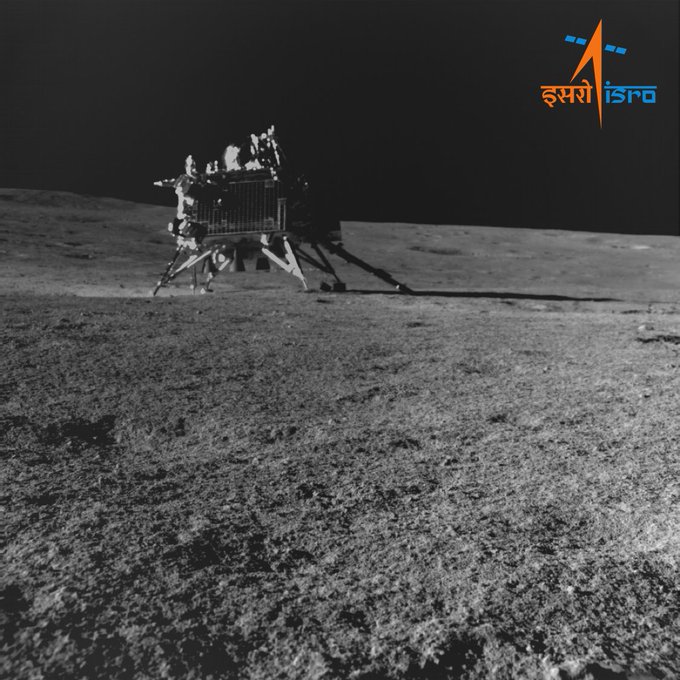
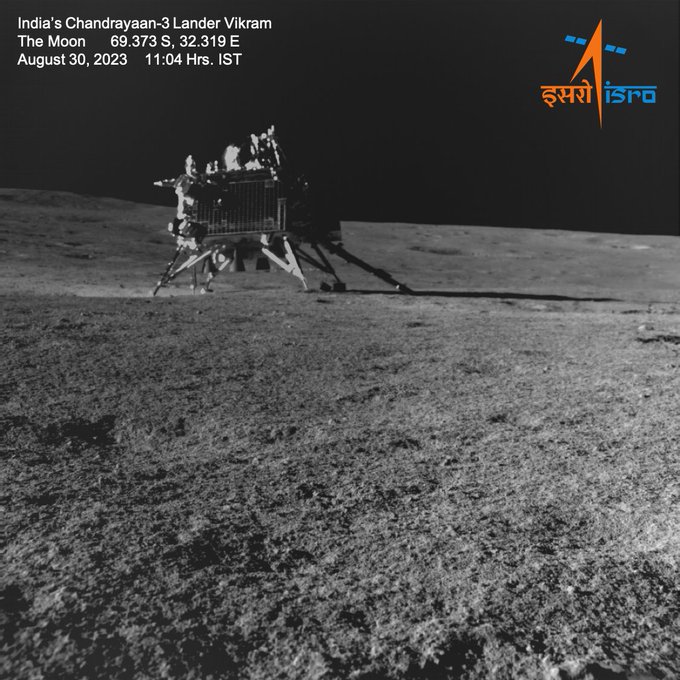
Beyond Borders, Across Moonscapes:
India's Majesty knows no bounds!.
Once more, co-traveller Pragyan captures Vikram in a Snap!
This iconic snap was taken today around 11 am IST from about 15 m.
The data from the NavCams is processed by SAC/ISRO, Ahmedabad.


Re: Chandrayaan 3: Launch and Discussions
FWIW to add . Enough time, to decide/implement ...Most likely scenario is RHU type unit ( Pu238) to keep the electronics warm in lunar night and solar power instead of RTG to supply power in the night but that can happen too depending on the requirements -- Process to produce Pu288 is challenging but India can produce it too, anyway small quantity is needed ) -- See my previous posts (or any good textbook reference for more details)
-
sanjaykumar
- BRF Oldie
- Posts: 6118
- Joined: 16 Oct 2005 05:51
Re: Chandrayaan 3: Launch and Discussions
That photograph makes it clear that attitude control was critical in the mission. I did not see any data display, accelerometers or star backgrounds, during de orbiting. Or was it included in the graphic of the lander as the most intuitive representation?
Re: Chandrayaan 3: Launch and Discussions
As the lander retargeted and landed on a different spot, there would be little fuel left in the tanks.
Hypothetically, if some fuel was left in the tanks would it be a good idea to fire the engine and move to another location where there is daylight available?
Then we can get 28 days of continuous daylight.
Hypothetically, if some fuel was left in the tanks would it be a good idea to fire the engine and move to another location where there is daylight available?
Then we can get 28 days of continuous daylight.
-
sanjaykumar
- BRF Oldie
- Posts: 6118
- Joined: 16 Oct 2005 05:51
Re: Chandrayaan 3: Launch and Discussions
What would an earth view look like from the rover? Still waiting.
Re: Chandrayaan 3: Launch and Discussions
FWIW: Did those atomic spectrums 50 years ago (before lasers)..
Here is S --
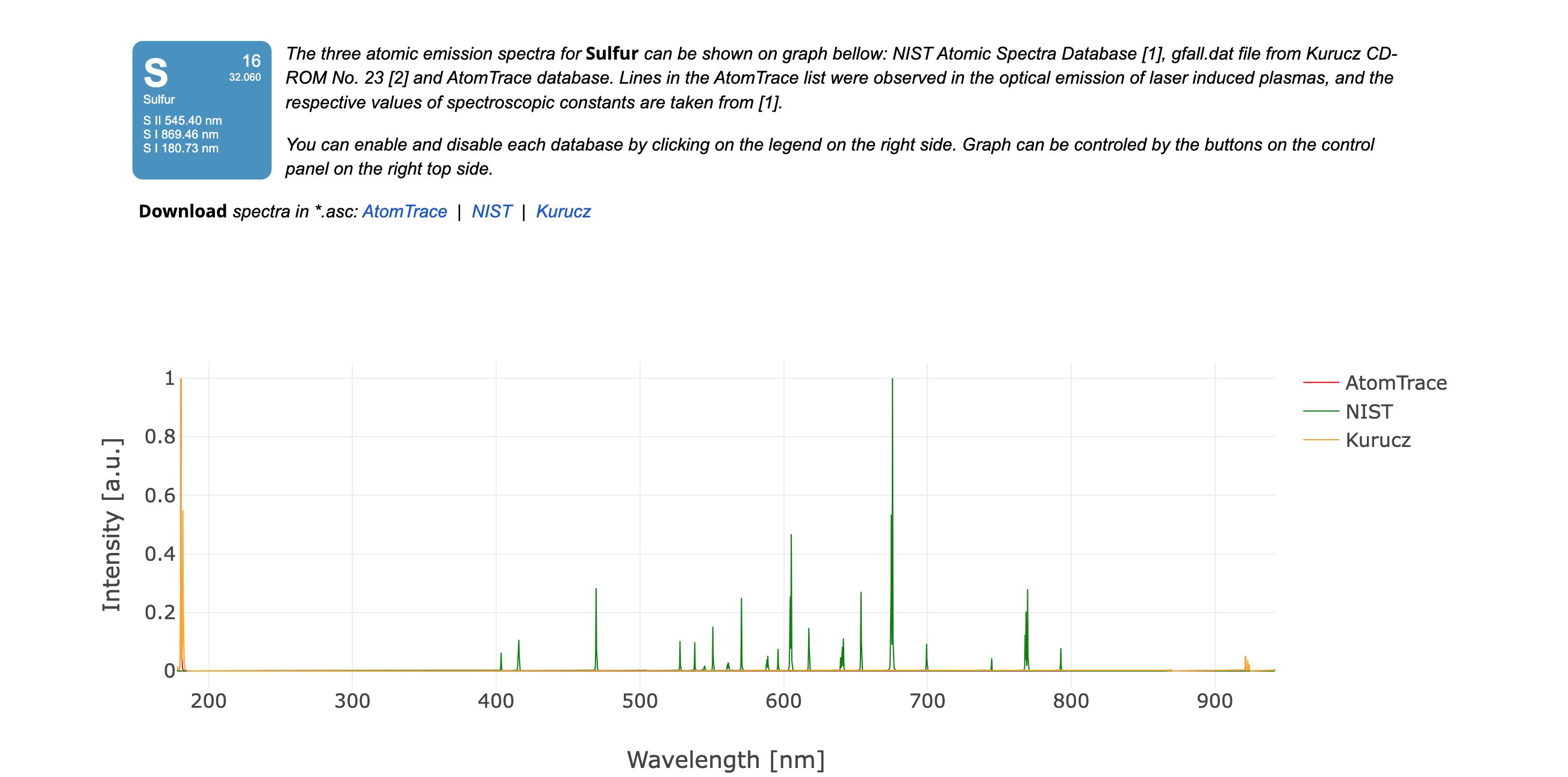

(Find all not so prominent lines, say here:https://physics.nist.gov/PhysRefData/Ha ... table2.htm
Or https://www.atomtrace.com/elements-data ... nt/16#NIST
Re: Chandrayaan 3: Launch and Discussions
Vikram picture shows the amount of light available due to low Sun Elevation.
Re: Chandrayaan 3: Launch and Discussions
The lander that NASA is sending in a couple of months will be able to shift location but not sure if it will move enough to always be in the sun. The landing point is 84 degree south latitude.Piyal.g wrote: ↑31 Aug 2023 02:48 As the lander retargeted and landed on a different spot, there would be little fuel left in the tanks.
Hypothetically, if some fuel was left in the tanks would it be a good idea to fire the engine and move to another location where there is daylight available?
Then we can get 28 days of continuous daylight.
NASA has ambitious plans to send man to the moon in the next 2-3 years and the way they want to do it is also very ambitious. They intend to built a space station (gateway) that orbits around the moon. The moon lander will be sent and docked at the gateway ahead of the astronauts. Once the astronauts reach the gateway and dock to it, they will transfer to the lunar lander and land on the moon. They can supposedly land on any part of the moon. The budgets involved are astronomical.
Re: Chandrayaan 3: Launch and Discussions
Why almost all the photos are Black and White. I'm sure there must be a reason. It will be great if we can get color videos. May be bandwidth is the bottleneck.
Re: Chandrayaan 3: Launch and Discussions
New video from ISRO
https://twitter.com/isro/status/1697156752641536030
https://twitter.com/isro/status/1697156752641536030
Chandrayaan-3 Mission:
The rover was rotated in search of a safe route. The rotation was captured by a Lander Imager Camera.
It feels as though a child is playfully frolicking in the yards of Chandamama, while the mother watches affectionately.
Isn't it?
Re: Chandrayaan 3: Launch and Discussions
29.53059 days is the synodic period (phase cycle).Amber G. wrote: ↑27 Aug 2023 00:37 While I was listening to PM Modi's speech (Youtube link is here in many of the posts), I was happy that he asked newer generation to study scientific texts like Surya Sidhanta - *and* modern scientific data and how these can be brought into modern scientific language. So just for fun, here is a challenge:
In Surya Sidhant we are given a few different figures of length of Lunar month : (I am giving approximate values in modern (commonly know) units (All in days); (There figures are given, how many cycles it will make in a whole yuga etc.)
1 - 29.53059 days
2 - 27.32158 days
3 - 27.32166 days
4 - 27.55455 days
5 - 27.21222 days
These are the *average( length of different cycles* (all in days) for 'full rotation' to calculate the exact position (naxtra) of the Moon, if you knew a position at one time... or to help you make a panchng of a particular year.
Challenge Q: What these different cycles represent? Why they are (slightly but noticeably) different from each other?
(If you know the answer, wait for a day or so before explaining -- if you did not know the answer before , and figured it out, please do comment)
(These values are pretty close to modern values, BTW)
The sidereal period (time taken for the moon to come back to the same nakshatra, as seen from the earth) is either 27.32158 days, or 27.32166 days (not sure which).
What are the other cycle times?